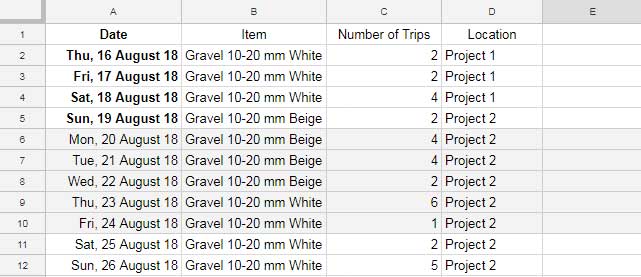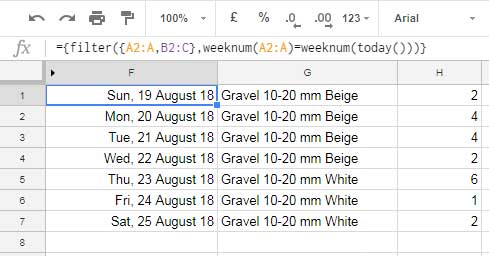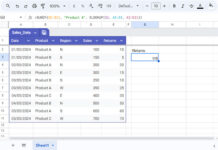In Google Sheets, the best function to conditionally sum current work week range is the Query.
The reason, it can handle multiple conditions similar to SUMIFS and is more flexible.
In the below demo data, I have highlighted the rows that contain the data in the current work week.

The range is from Mon, 20 August 2018 to Fri, 24 August 2018. As per my system, today is Tue, 21 August 2018.
This sample data shows the date wise report of the number of trips (stone/aggregate material) transported to two different project sites.
Query to Sum Current Work Week Range in Google Sheets
Conditions:
1. Dates in Column A should be within the current work week.
2. The Items in Colum B should be “Gravel 10-20 mm Beige”.
Sum Range:
It’s the Column C containing the number of trips.
Note: If you only have the condition 1 above, then I recommend you to use the SUMIF based solution, which is more clean and elegant. Here is that tutorial – SUMIF to Sum By Current Work Week.
Since we have multiple conditions and there is no easy way to use SUMIFS, the best way to find the answer is Query.
The Query Formula to Conditionally Sum Current Work Week Range
Formula:
=sum(query({filter({A2:A,B2:C},weeknum(A2:A)=weeknum(today()))},"Select Col3 where DayofWeek(Col1)>=2 and DayofWeek(Col1)<=6 and Col2='Gravel 10-20 mm Beige'"))
Result: 10
How this Query formula conditionally sum current work week range?
Let me explain it.
Query Syntax:
QUERY(data, query, [headers])
I am detailing my above Query formula in line with this Query syntax arguements.
1. DATA
In the Query formula, the data (range) is the below FILTER formula.
={filter({A2:A,B2:C},weeknum(A2:A)=weeknum(today()))}
This formula extracts the rows containing the current week’s date in Column A. It is the current week, not current work week. The WEEKNUM function plays the trick.
For explaining this to you, I am applying this filter in a blank range in my sheets. Here is that.

2. QUERY
"Select Col3 where DayofWeek(Col1)>=2 and DayofWeek(Col1)<=6 and Col2='Gravel 10-20 mm Beige'"
This is the Query. This helps me to sum Column 3 (Number of Trips) if the Column 2 items are “Gravel 10-20 mm Beige” and;
The DayofWeek in Colum 1 (date) are between the range>=2 and<=6 where 2 represents Monday and 6 represents Friday.
The DayofWeek Scalar function helps me to reduce the filter range to the current work week.
3. HEADER
It’s optional and so I haven’t included this in my formula.
Additional Tips About this Query to Sum Current Work Week Range in Google Sheets.
I want to refer my Query condition “Gravel 10-20 mm Beige” to a cell, for example to cell F10.
This is the relevant part of the Query.
Col2='Gravel 10-20 mm Beige'
Here is the modified version.
Col2='"&F10&"'
Hope this tutorial could help you to learn how to use Query to sum current work week range in Google Sheets.





















